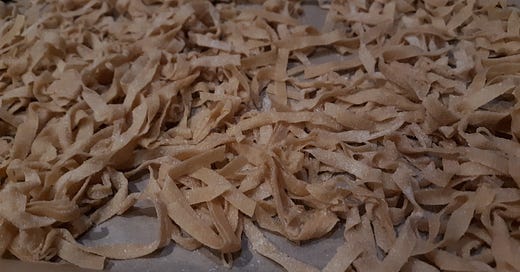What’s the difference? The brand name, Kamut was given to the ancient grain, Khorasan wheat by Bob Quinn, in an effort to preserve the grain and promote it as a superior grain on the market. Many people have confused Kamut and Khorasan, thinking they are two different varieties of wheat, but they are not. Kamut is a trademarked name, whereas Khorasan is the actually name of the wheat species.
When shopping for this particular wheat, and if you don’t find Kamut with suppliers, check for organic Khorasan wheat instead. That’s what I did. I also remember when searching for information regarding the wheat for recipes and the like. More than likely you will find plenty of information about Kamut which you can apply to Khorasan as well.
Just as Kleenex® is a well-known brand of facial tissue, Kamut® is a brand that markets Khorasan. Kamut® is not a wheat variety but a brand name that sells Khorasan wheat. The popularity of the Kamut® brand has led many to mistakenly believe that Kamut® is the name of the wheat variety when, in fact, it is simply a marketing label for Khorasan. — Grand Teton, Ancient Grains
Baking with Khorasan
Khorasan wheat is the ancestor of Durum wheat and is great for making pasta. I thought I would prefer to sift the wheat after milling for pasta for texture in the finished product, but I didn’t need to with Khorasan wheat, it was soft
. Some pasta is traditionally made with soft white wheat, some with Durum wheat only and some with both flours for a “al dente" pasta.
I noticed a nuttier flavor from the freshly milled Khorasan wheat made into pasta than I had ever tasted with all purpose flour. There was no comparison, at least to me. Now the taste of pasta with all purpose flour sort of tastes like wallpaper paste. I wish I’d discovered this decades ago…the things I’ve been missing! I’d made pasta years ago with all purpose flour but this was my first pasta made with freshly milled flour. I used organic Khorasan wheat berries I purchased from Azure Standard.
There’s a story behind this too…watch to hear my confession and why he married me anyway.
Modern Conveniences Making Pasta
I like the convenience of modern appliances and made my pasta with my food processor and my pasta machine. The process is much easier with them than without, but I still learned a few things I’d do better next time. Just so you know…
Making shorter noodles that hang on one spindle of the drying rack, not the entire side of the rack.
Use additional flour trays for one layer of noodles to aide in drying evenly.
Positioning the pasta machine closer to the edge of the counter to facilitate handling the noodles as they come out of the machine.
Flipping the pasta sheet over the machine and out of the way of the noodle extraction. I struggled with the pasta sheet covering the access to the noodles as they were extracted.
Kamut vs. Regular Pasta - Texture Taste and More
Nutritional Information
Kamut: The High-Energy, High-Nutrient Ancient Grain
One cup (approximately 172 grams) of cooked Kamut has about:
251 calories
52.4 grams carbohydrates
11.1 grams protein
1.6 grams fat
7 grams dietary fiber
2 milligrams manganese (104 percent DV)
304 milligrams phosphorus (30 percent DV)
4.7 milligrams niacin (24 percent DV)
96 milligrams magnesium (24 percent DV)
0.4 milligrams copper (21 percent DV)
3 milligrams zinc (20 percent DV)
3 milligrams iron (19 percent DV)
0.2 milligrams thiamin (14 percent DV)
0.14 milligrams vitamin B6 (7 percent DV)
20 micrograms folate (5 percent DV)
0.05 milligrams riboflavin, or vitamin B2 (3 percent DV)
17 milligrams calcium (2 percent DV)
Zinc is important for anyone with digestive or immune issues, and therefore important to include in your diet, especially if you have histamine or mast cell issues.
Easier to Digest
Khorasan wheat is considered an ancient grain and is easier to digest due to the different gluten structure in ancient grains vs. modern wheat. To make the transition even easier for you and your family who may be resistant to an abrupt change from processed bread to whole wheat, freshly milled flour is to make a gradual shift. Start exchanging 25% of the flour in your recipes with freshly milled flour and 75% all purpose flour that you’ve been using. Transition eventually to a 50/50 flour combination and then 75% freshly milled flour and 25% all purpose. Over time the family won’t even notice they’re eating 100% whole wheat, freshly milled flour. This transitioning gives our digestive systems a chance to evolve over time to the extra fiber and the change in bowel habits. Some may require sifting out the bran, or a portion of the bran, a way to pinpoint any remaining digestive issues.
Zebras - are you listening? There is a link to Ehlers Danlos with regards to hypermobility and folate (B9) status. Processed bread contains folic acid, a synthetic version of folate that about half of the population cannot assimilate and use in their bodies. Freshly milled flour still contains the wheat bran and germ which contains the most natural form of folate that our bodies are desperate for, especially for us zebras.
The common denominator is the MTHFR issues that has been attributed to almost all (there are exceptions) to Ehlers Danlos patients. The inability to not only use folic acid, but this synthetic version interferes with our ability to use folate when it is included in our diet.
Folate-dependent hypermobility syndrome: A proposed mechanism and diagnosis
Another reason to eat freshly milled flour, not to mention all the other vitamins and minerals it includes. You won’t get that in store bought flour!
Other Pasta Resources
I learned a lot from The Pasta Grannies YouTube channel - check it out




